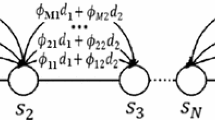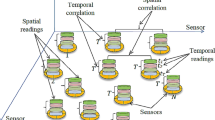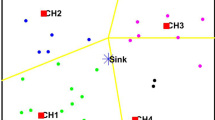Abstract
Wireless sensor networks (WSNs) used for pavement information monitoring usually have a long-chain structure; therefore, the sensor nodes in the network consume uneven amounts of energy. For the application of WSN technology to pavement monitoring, reducing the amount of data transmission in WSNs and balancing the energy consumption at the nodes are essential. This study proposes a data-acquisition mechanism for WSN pavement-monitoring systems based on hybrid compressed sensing (HCS) and establishes a simulation model of the system energy consumption. The data collection proposal is then compared with traditional data collection methods. Experimental results show that the application of HCS to a pavement-monitoring system can reduce the overall energy consumption of the network, balance power consumption among the nodes, and prolong the lifetime of the WSN sensors.















Similar content being viewed by others
References
Jorge, G., Rodolfo, H., Juan, M., Fernando, M., & álvaro, G. (2018). Smart sensing of pavement temperature based on low-cost sensors and V2I communications. Sensors, 18(7), 2092.
Whelan, M. J., & Janoyan, K. D. (2009). Design of a robust, high-rate wireless sensor network for static and dynamic structural monitoring. Journal of Intelligent Material Systems and Structures, 20(7), 849–863.
Shtayat, A., Moridpour, S., Best, B., Shroff, A., & Raol, D. (2020). A review of monitoring systems of pavement condition in paved and unpaved roads. Journal of Traffic and Transportation Engineering (English Edition), 7(5), 1–29.
Graziano, A. D., Marchetta, V., & Cafiso, S. (2020). Structural health monitoring of asphalt pavements using smart sensor networks: a comprehensive review. Journal of Traffic and Transportation Engineering, 7(5), 639–651.
Zhang, P., T. K., Boon, & Wang, Y. (2019). Sensor selection in wireless sensor networks for structural health monitoring. In 2019 IEEE Sensor (pp. 1–4).
Zhu, Y., Zhang, J., Li, L., & Peng W. (2010). Multiple ant colony routing optimization based on cloud model for WSN with Long-Chain structure. International Conference on Wireless Communications Networking and Mobile Computing, 45(2), 1–4.
Zhao, X., Yang, Q., & Zhang, Y. (2018). Synthesis of subarrayed linear array via l1-norm minimization compressed sensing method. In 2018 IEEE Asia-Pacific Conference on Antennas and Propagation (APCAP) (pp. 124–125).
Luo, C., Wu, F., Sun, J., et al. (2009). Compressive data gathering for large-scale wireless sensor networks. In: Fifteenth ACM International Conference on Mobile Computing and Networking (pp. 145–156).
Chen, W., & Wassell, I. J. (2012). Energy-efficient signal acquisition in wireless sensor networks: a compressive sensing framework. Iet Wireless Sensor Systems, 2(1), 1–8.
Li, S., Xu, L. D., & Wang, X. (2013). Compressed sensing signal and data acquisition in wireless sensor networks and internet of things. IEEE Transactions on Industrial Informatics, 9(4), 2177–2186.
Liu, Y., Zhang, J. H., Wang, Y. G., Liu, L. B., & Li, H. M. (2020). An improved gaussian frequency domain sparse inversion method based on compressed sensing. Applied Geophysics, 17(3), 443–452.
Zhao, W., Sun, B., Tong, W., & Zhi, Y. (2018). On-chip neural data compression based on compressed sensing with sparse sensing matrices. IEEE Transactions on Biomedical Circuits and Systems, 99, 1–13.
Qie, Y., Hao, C., & Song, P. (2020). Wireless transmission method for large data based on hierarchical compressed sensing and sparse decomposition. Sensors, 20(24), 7146.
Zhang, Z., Rao, B. D., & Jung, T. P. (2013). Compressed sensing for energy-efficient wireless telemonitoring: challenges and opportunities. IEICE Transactions on Fundamentals of Electronics, Communications and Computer Sciences, 118, 80–85.
Qi, C., & Wu, L. (2011). A hybrid compressed sensing algorithm for sparse channel estimation in MIMO OFDM systems. 2011 IEEE International Conference on Acoustics, Speech and Signal Processing, 125(3), 3488–3491.
Tong, Z., Yuan, D., Gao, J., Wei, Y., & Dou, H. (2019). Pavement-distress detection using ground-penetrating radar and network in networks. Construction and Building Materials, 233, 117352.
Liao, W., Zhuang, Y., Zeng, C., Deng, W., & Ma, H. (2020). Fiber optic sensors enabled monitoring of thermal curling of concrete pavement slab: temperature, strain and inclination. Measurement, 165, 108203.
Kong, L. J. (2020). Design and realization of distributed wireless temperature detection system based on zigbee technology. Australian Journal of Electrical and Electronics Engineering, 17(11), 1–9.
Yan, X., Yang, B., & Yan, N. A. (2014). An optimised deployment method for chain-type wireless sensor network based on energy efficiency. International Journal of Sensor Networks, 16(3), 148–155.
Xiao, J., Zou, X., & Xu, W. (2017). Epave: a self-powered wireless sensor for smart and autonomous pavement. Sensors, 17(10), 2–24.
Abdulrahman, A., Abdulmalik, A. S., Mansour, A., Ahmad, A., Suheer, A. H., Mai, A. A., et al. (2016). Ultra wideband indoor positioning technologies: analysis and recent advances. Sensors, 16(5), 1–36.
Acknowledgements
This work is supported by the Key Project of Research and Development Program of Shaanxi Province of China (Grant No. 2021GY-54).
Author information
Authors and Affiliations
Corresponding author
Additional information
Publisher's Note
Springer Nature remains neutral with regard to jurisdictional claims in published maps and institutional affiliations.
Rights and permissions
About this article
Cite this article
Xiao, J., Gao, F., Li, P. et al. Data Acquisition Mechanism of Wireless Sensor Network Pavement Monitoring System Based on Hybrid Compressive Sensing. Wireless Pers Commun 121, 1707–1724 (2021). https://doi.org/10.1007/s11277-021-08693-9
Accepted:
Published:
Issue Date:
DOI: https://doi.org/10.1007/s11277-021-08693-9




